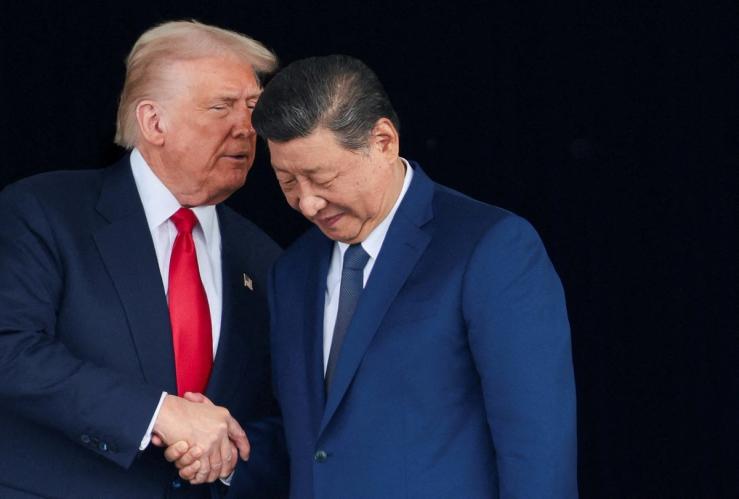Andy’s view
Toward the end of his life, former US President Richard Nixon admitted a secret anxiety: His greatest foreign policy triumph — a Cold War détente with China aimed at countering the Soviet Union — “may have created a Frankenstein.”
Nixon’s was the first of three big bets the US made on China in the modern era; all had unintended consequences. In seeking a strategic partner, Nixon helped birth a geopolitical heavyweight beyond America’s control; he feared the two countries would one day go to war. In 2001, then-President Bill Clinton brought China into the World Trade Organization to encourage a liberal turn in Beijing, but instead fast-tracked the rise of a rigidly authoritarian economic rival.
And then, beginning in his first term, President Donald Trump rolled the dice a third time by imposing a punishing regime of sanctions, tariffs, and technology curbs to impede China’s development. But that backfired too, turbocharging the country’s technological ascent. The result: a trade truce hammered out at a summit in South Korea this week between Trump and Chinese leader Xi Jinping.
Trump was ebullient after his first meeting with Xi in six years, declaring that China had agreed to pause controls on exports of rare earth metals, buy “tremendous amounts” of soybeans, and step up action to stop the flow of precursor chemicals used to make fentanyl. In return, Trump agreed to halve fentanyl-linked tariffs and postpone plans to impose steep fees on Chinese-built or Chinese-owned ships at US ports. On a scale of zero to 10, Trump told reporters, “the meeting was at a 12.”
In fact, the deal merely restores a status quo that existed before Trump started ratcheting up tariffs this year, and it fails to address fundamental problems in their relationship.
Ultimately, Trump backed down from a fight against a technological superpower that would have been too costly for the US.
In fact, it was Trump’s own punitive controls that spurred Xi’s tech ambitions. The more Washington tried to suppress its rival, the faster Xi invested in homegrown innovation. Chinese tech champion Huawei Technologies, Trump’s initial target in 2019, counterintuitively gained momentum thanks to the US pressure campaign, developing an entire AI ecosystem — including software and data centers — using its own chips.
And as Xi saw his ultimate goal of technological self-sufficiency coming into view, he gained confidence to retaliate hard against US economic coercion, a tit-for-tat strategy that his trade negotiators masterfully exploited.
This week’s truce buys Xi time to achieve further tech breakthroughs. Trump will use the lull in hostilities to build a secure rare earths supply chain. Nobody should be fooled: This trade deal, along with an agreement for Trump to visit Beijing in April, is tactical. The two sides are long-term antagonists. Minutes before meeting Xi, Trump ordered the Pentagon to resume nuclear weapons testing.
For more than half a century, US bets on China have had a compelling logic. Nixon’s “opening to China” was driven by realpolitik: mutual antipathy to the Soviet Union brought the US and China together. Clinton’s embrace of China was motivated by a hope of liberal change in China that seemed plausible at the time; Beijing was preparing to host the 2008 Summer Olympics, and economic reformists in China spoke of “converging with international standards.” When Trump came to power, Americans were ready to abandon a policy of economic engagement with China that had hollowed out US industry, left desolation across factory towns, and fueled a populist surge.
Yet, in the end, each of those wagers failed, leading to this moment.
But now, Washington is placing another big bet, this time hoping to beat China at its own game. Industrial policy — or state capitalism, as the Chinese variant is called — has gone mainstream in Washington. Recent examples include the government taking a 10% stake in Intel, acquiring a “golden share” in United States Steel Corp., and offering to lift export restrictions on sales of Nvidia chips to China in return for a cut of the revenue.
Economists warn that industrial policy will lead to misallocated capital, less innovation, poorer-quality goods and services, and, ultimately, slower growth. If the history of US policy towards China is any guide, this wager won’t end well, either.
In this article:
Room for Disagreement
For a coterie of experts, Trump’s mistake was not in taking a hard line towards China, but in not holding that line. The political scientist Hal Brands argued over the summer that during his first term, the US president recognized “that an increasingly autocratic, assertive China sought to ‘shape a world antithetical to US values and interests’,” concluding: “Trump’s reward for retreating in the new cold war could be increased risk of a hot one.” Others posit that China’s economy is weaker than appears on the surface, suggesting further American pressure could force Beijing’s hand.
Notable
- Business Insider asked 25 experts how they foresaw the future of US-China relations. “All the results are bleak.”


